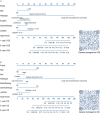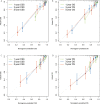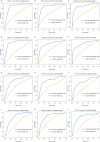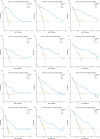Construction and validation of nomograms based on the log odds of positive lymph nodes to predict the prognosis of lung neuroendocrine tumors
- PMID: 36211370
- PMCID: PMC9539638
- DOI: 10.3389/fimmu.2022.987881
Construction and validation of nomograms based on the log odds of positive lymph nodes to predict the prognosis of lung neuroendocrine tumors
Abstract
Background: This research aimed to investigate the predictive performance of log odds of positive lymph nodes (LODDS) for the long-term prognosis of patients with node-positive lung neuroendocrine tumors (LNETs).
Methods: We collected 506 eligible patients with resected N1/N2 classification LNETs from the Surveillance, Epidemiology, and End Results (SEER) database between 2004 and 2015. The study cohort was split into derivation cohort (n=300) and external validation cohort (n=206) based on different geographic regions. Nomograms were constructed based on the derivation cohort and validated using the external validation cohort to predict the 1-, 3-, and 5-year cancer-specific survival (CSS) and overall survival (OS) of patients with LNETs. The accuracy and clinical practicability of nomograms were tested by Harrell's concordance index (C-index), integrated discrimination improvement (IDI), net reclassification improvement (NRI), calibration plots, and decision curve analyses.
Results: The Cox proportional-hazards model showed the high LODDS group (-0.79≤LODDS) had significantly higher mortality compared to those in the low LODDS group (LODDS<-0.79) for both CSS and OS. In addition, age at diagnosis, sex, histotype, type of surgery, radiotherapy, and chemotherapy were also chosen as predictors in Cox regression analyses using stepwise Akaike information criterion method and included in the nomograms. The values of C-index, NRI, and IDI proved that the established nomograms were better than the conventional eighth edition of the TNM staging system. The calibration plots for predictions of the 1-, 3-, and 5-year CSS/OS were in excellent agreement. Decision curve analyses showed that the nomograms had value in terms of clinical application.
Conclusions: We created visualized nomograms for CSS and OS of LNET patients, facilitating clinicians to bring individually tailored risk assessment and therapy.
Keywords: log odds of positive lymph nodes; lung neuroendocrine tumor; nomogram; predictor; survival.
Copyright © 2022 Wang, Wei, Guo, Xu, Lv, Yu and Liu.
Conflict of interest statement
The authors declare that the research was conducted in the absence of any commercial or financial relationships that could be construed as a potential conflict of interest.
Figures






Similar articles
-
Dynamic nomograms combining N classification with ratio-based nodal classifications to predict long-term survival for patients with lung adenocarcinoma after surgery: a SEER population-based study.BMC Cancer. 2021 Aug 4;21(1):653. doi: 10.1186/s12885-021-08410-6. BMC Cancer. 2021. PMID: 34344326 Free PMC article.
-
A prognostic nomogram based on log odds of positive lymph nodes to predict the overall survival in biliary neuroendocrine neoplasms (NENs) patients after surgery.J Endocrinol Invest. 2022 Dec;45(12):2341-2351. doi: 10.1007/s40618-022-01874-8. Epub 2022 Jul 30. J Endocrinol Invest. 2022. PMID: 35908009
-
Prognostic nomogram based on the lymph node metastasis indicators for patients with bladder cancer: A SEER population-based study and external validation.Cancer Med. 2023 Mar;12(6):6853-6866. doi: 10.1002/cam4.5475. Epub 2022 Dec 7. Cancer Med. 2023. PMID: 36479835 Free PMC article. Clinical Trial.
-
Commonwealth Neuroendocrine Tumour Research Collaboration and the North American Neuroendocrine Tumor Society Guidelines for the Diagnosis and Management of Patients With Lung Neuroendocrine Tumors: An International Collaborative Endorsement and Update of the 2015 European Neuroendocrine Tumor Society Expert Consensus Guidelines.J Thorac Oncol. 2020 Oct;15(10):1577-1598. doi: 10.1016/j.jtho.2020.06.021. Epub 2020 Jul 11. J Thorac Oncol. 2020. PMID: 32663527
-
Emerging Precision Medicine Approaches for Lung Neuroendocrine Tumors.Cancers (Basel). 2023 Nov 25;15(23):5575. doi: 10.3390/cancers15235575. Cancers (Basel). 2023. PMID: 38067279 Free PMC article. Review.
Cited by
-
Construction and validation of novel nomograms based on the log odds of positive lymph nodes to predict the prognosis of papillary thyroid cancer: a retrospective cohort study.Front Endocrinol (Lausanne). 2025 Mar 7;16:1411426. doi: 10.3389/fendo.2025.1411426. eCollection 2025. Front Endocrinol (Lausanne). 2025. PMID: 40123892 Free PMC article.
-
A Nomogram Based on the Log Odds of Positive Lymph Nodes Predicts the Prognosis of Patients with Colon Neuroendocrine Tumors After Surgery: A Surveillance, Epidemiology, and End Results Population-Based Study.Technol Cancer Res Treat. 2023 Jan-Dec;22:15330338231180776. doi: 10.1177/15330338231180776. Technol Cancer Res Treat. 2023. PMID: 37345370 Free PMC article.
References
Publication types
MeSH terms
LinkOut - more resources
Full Text Sources
Medical

